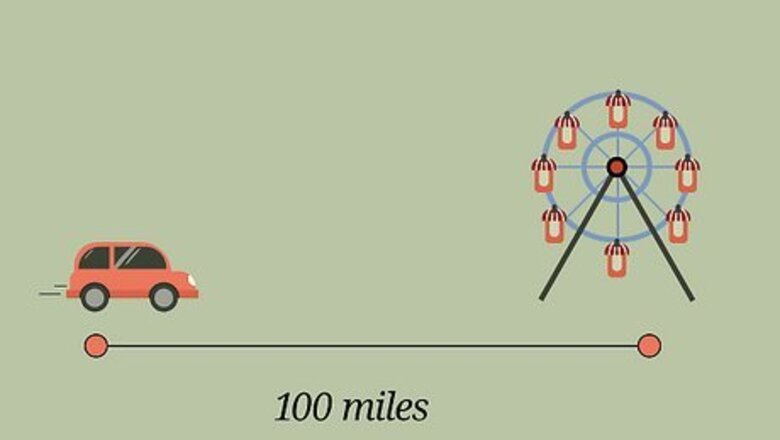
views
Using the Standard Speed Equation
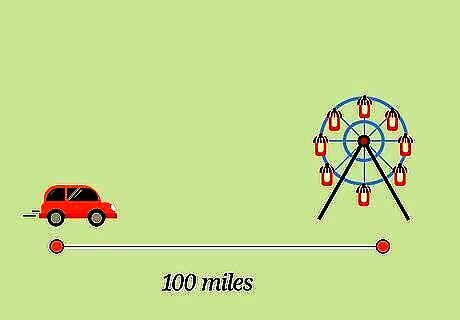
Find the distance that an object has traveled. The basic equation that most people use to figure out how fast something is going is very easy to use. The first thing you'll need to know is how far the object traveled. In other words, how far is its starting point from its ending point? This equation will be easier to understand with an example. Let's say that we are making a trip in a car to a theme park 100 miles away (about 161 kilometers). In the next few steps, we'll use this information to solve our equation.

Find the time that the object took to travel that distance. The next piece of information you'll need is how long the object took as it traveled. In other words, how long did it take to get from its starting point to its ending point? In our example, let's say that it took us almost exactly two hours to make our journey.
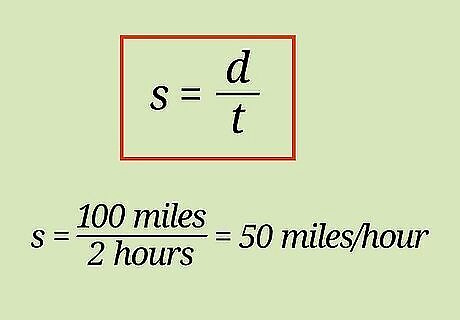
Divide the distance by the time to find the speed. All you need are these two pieces of information to find your speed for the trip. The distance over the time will give you the object's speed. In our example, 100 miles/2 hours = 50 miles/hour (about 80 kilometers/hour).
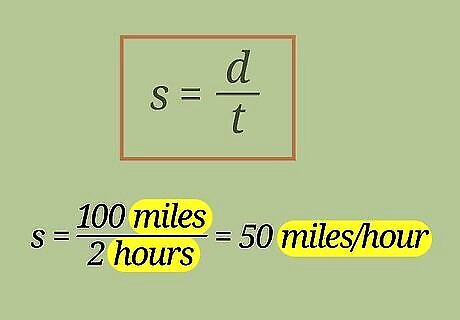
Don't forget your units. Labelling your answer with the proper units (like miles per hour, etc.) is critical. Without units, it can be hard for other people to understand what your answer means. You may also lose points if you're making this calculation for schoolwork. Your units for speed will be your distance units over your time units. In our example, since we measured distance in miles and time in hours, our units are miles/hour (or "miles per hour").
Solving Intermediate Problems
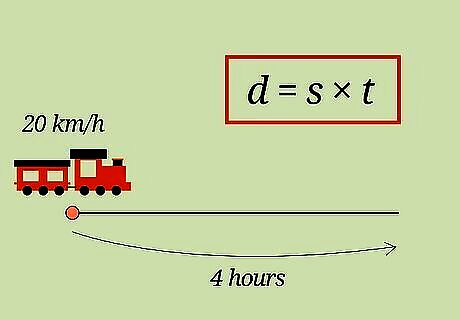
Isolate the different variables to solve for distance and time. Once you know the basics of the speed equation, you can use it to find more than just speed. For example, if you start out knowing speed and one of the other variables, you can rearrange the equation to find the missing piece of information. For example, let's say that we know that a train traveled at 20 kilometers per hour for four hours, but we need to know how far it went. In this case, we can rearrange the equation and solve like this: speed = distance/time speed × time = (distance/time) × time speed × time = distance 20 km/h × 4 h = distance = 80 kilometers
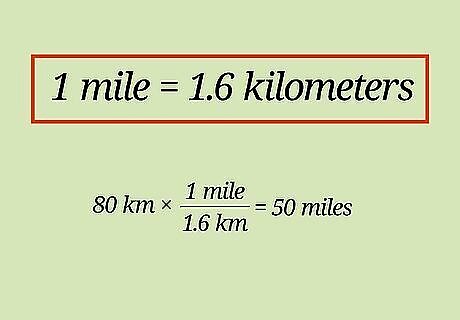
Convert your units as needed. Sometimes, you may calculate speed in one set of units but need it in another. In this case, you'll need to use conversion factors to get your answer into the correct units. To do this, just write the relationships between your units as a fraction and multiply. When you multiply, flip your fraction as needed to get rid of the units you don't want. This is a lot easier than it sounds! For example, let's say that in the example problem above, we need our answer in miles instead of kilometers. There are about 1.6 kilometers in a mile, so we can convert like this: 80 kilometers × 1 mile/1.6 kilometers = 50 miles Note that because kilometers appears on the bottom of the fraction, it cancels with the kilometers in the original answer, leaving the answer in miles. This site contains conversions for most common units.
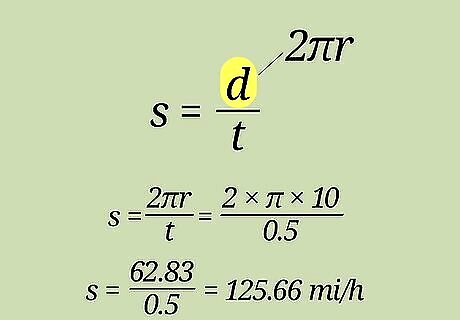
Replace the "distance" variable with distance formulas as needed. Objects don't always travel in nice, convenient straight lines. In cases when they don't, you may not be able to simply plug a numerical value for distance into the standard speed equation. Instead, you may need to replace the d in s = d/t with a formula that models the distance the object traveled. For example, let's say that an airplane flies in a circle that is 20 miles wide five times. The plane completes this journey in half an hour. In this example, we still need to find exactly how far the plane has traveled before we can find its speed. We can use the equation for the distance around a circle (its circumference) in place of d in our equation. This equation is circumference = 2πr where r = the circle's radius. We would solve like this: s = (2 × π × r)/t s = (2 × π × 10)/0.5 s = 62.83/0.5 = 125.66 miles/hour
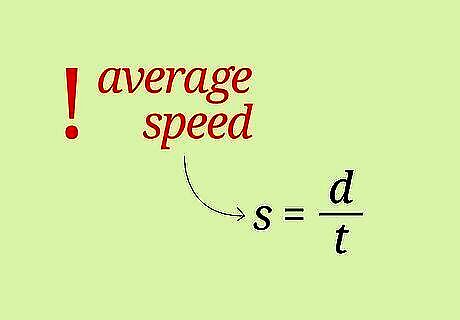
Understand that s = d/t gives an average speed. The simple, convenient equation we have been using to find speed has one significant flaw. The value it gives you is technically an average speed. This means that it assumes the object you're measuring went the same speed for the whole trip. As we'll see below, finding an object's speed at a single given moment can be more difficult. To illustrate this difference, imagine the last trip you took in a car. It's highly unlikely that you traveled the same speed for the whole trip. Instead, you started out slow and gradually reached your cruising speed, slowing down at stoplights, traffic jams, and so on. If you use the standard speed equation to figure out your speed for the trip, these changes in speed won't be reflected. Instead, you'll get an answer that's somewhere in the middle of all the different speeds you traveled at.
Calculating Instantaneous Speed
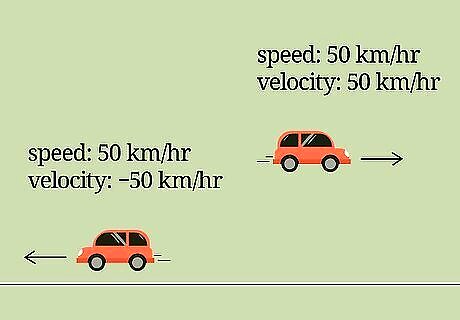
Understand that speed is defined as the magnitude of velocity. Higher-level speed calculations can get confusing because mathematicians and scientists use different definitions for "speed" and "velocity". A velocity has two components: a magnitude and a direction. The magnitude is equal to the object's speed. A change in the direction will cause a change in the velocity, but not in the speed. For example, let's say that there are two cars moving in opposite directions. Both cars' speedometers read 50 km/hr, so they both have the same speed. However, since they are moving apart from each other, we say that one car has a velocity of -50 km/hr and one has a velocity of 50 km/hr. Just as you can calculate instantaneous speed, you can also calculate instantaneous velocity.
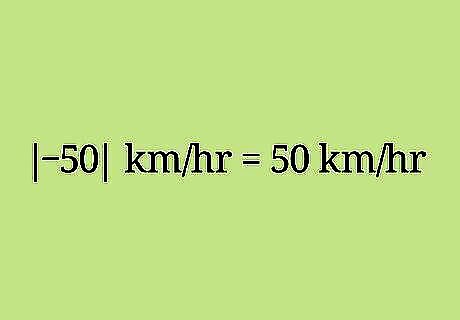
Use absolute values for negative velocities. Objects can have velocities with a negative magnitude (if they are moving in a negative direction relative to something else). However, there's no such thing as a negative speed, so in these cases the absolute value of the magnitude gives the object's speed. For this reason, in the example problem above, both cars have a speed of 50 km/hr.
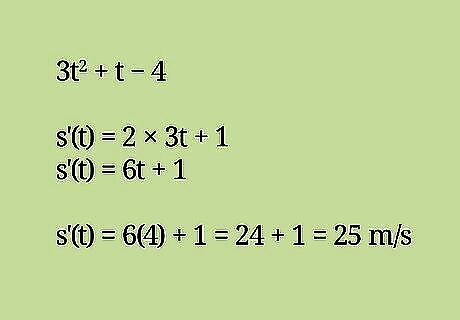
Take the derivative of a position function. If you have a function s(t) that gives you the position of an object with regards to time, the derivative of s(t) will give you its velocity with regards to time. Just plug a time value into this equation for the variable t (or whatever the time value is) to get the velocity at this given time. From here, finding the speed is easy. For example, let's say that an object's position in meters is given with the equation 3t + t - 4 where t = time in seconds. We want to know what the speed of the object is at t = 4 seconds. In this case, we can solve like this: 3t + t - 4 s'(t) = 2 × 3t + 1 s'(t) = 6t + 1 Now, we plug in t = 4: s'(t) = 6(4) + 1 = 24 + 1 = 25 meters/second. This is technically a velocity measurement, but since it's positive and direction is not mentioned in the problem, we can essentially use it for speed.
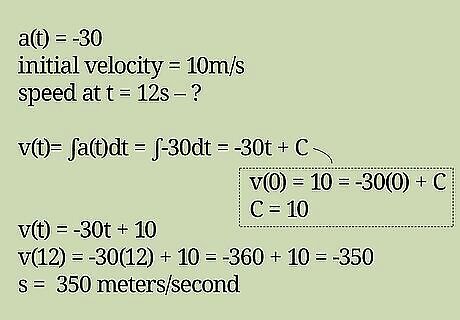
Take the integral of an acceleration function. Acceleration is a way of measuring the change in an object's velocity over time. This topic is a little too complex to explain fully in this article. However, it's useful to note that when you have a function a(t) that gives acceleration with regards to time, the integral of a(t) will give you velocity with regards to time. Note that it's helpful to know the object's initial velocity so that you can define the constant that results from an indefinite integral. For example, let's say that an object has a constant acceleration (in m/s given by a(t) = -30. Let's also say that it has an initial velocity of 10 m/s. We need to find its speed at t = 12 s. In this case, we can solve like this: a(t) = -30 v(t)= ∫ a(t)dt = ∫ -30dt = -30t + C To find C, we'll solve v(t) for t = 0. Remember that the object's initial velocity is 10 m/s. v(0) = 10 = -30(0) + C 10 = C, so v(t) = -30t + 10 Now, we can just plug in t = 12 seconds. v(12) = -30(12) + 10 = -360 + 10 = -350. Since speed is the absolute value of velocity, the object's speed is 350 meters/second.




















Comments
0 comment